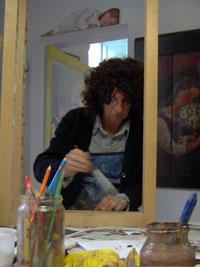Felice Rossello's critique of Imelda



" Nothing is ever still : the passing of time and the flowing of ideas became a path to travel without stopping. There are stages, straight roads, blind alleys, short cuts and very narrow roads. What we see are the imprints left while passing through. We can follow them to find Imelda but to do it we have to walk without stopping, always seeking in the corners, inside the trunks, in the soul of old wood things scattering soul and colours everywhere. After walking for so long maybe we will be able to see her while she’s going away once more.
This is the key - I told myself - the key to her painting is just in this presentation that I found in Imelda’s curriculum vitae.
That’s why, when I went into her studio, I felt the need to walk among her works. What she suggests us, with each piece of her work, is not only a journey within ourselves, but also inside things.
What you feel it’s a colourful sensation.
Yet there is a but...yes there are colours but the figures are always pensive, the landscape always empty, metaphysical, suspended. The few times I go to a painter’s or sculpture’s studio I like to wander to grasp the atmosphere. Immodestly I feel a bit like Maigret, when on the scene of a crime he tries to understand the environment in which the action has happened. Now, art is not a crime, but certainly in an artist’s studio you can breath a “certain” atmosphere like on the scene of a crime: the atmosphere, the world of the artist who creates the works.
That’s why I started walking round the three rooms where Imelda carries out her works and I tried to live in her world.
So I found myself surrounded by little boys and little girls hanged in a fanciful world, as well as by landscapes of cubist reminiscence, dreaming young ladies and lovers. In short I was in an idealized and varied world. If I may venture a dating a bit like Charleston, you know in the twenties.
Artistically speaking 2006 is for her a fatidic year. In May Imelda makes a historical decision. She told herself : “It’s time to move on from painting to sculpture!” I think it’s part of her nature to be never pleased with herself, therefore she decides to go from the two dimensions painting to three dimensions sculpture.
In June 2006 in Marseille, she decides to make wood sculptures and abandons the first idea of making them in ceramic.
Wood is warmer, more familiar for her, besides ceramic in Savona, and especially in Albisola, is overused.
Another of Imelda’s characteristics is to be coherent and not always look for the financial aspect.
The stages of changing from one type of work to another are written in a small diary where there are some notes followed by preliminary sketches.
She says, “I don’t usually make preliminary sketches. When I paint a picture I give my imagination and instinct free rein but not this time. Maybe what I felt was important.”
Above all this is what she wants me to recount of her painting. I understand from our conversation that she prefers me to relate this latest evolution rather than her general work. A vision of the world grows from her works. A world like the one she would like: lovers, children, villages, there is never violence, a suspension from the brutal reality, a world of game, but also reflective, intense and thoughtful about existence.
What really struck me is that Imelda transforms any material in works of art. For instance window or door shutters are painted with female or male figures, a ceiling is frescoed by her with children playing. Among all these things she suddenly, but calmly and peacefully points to a piece of wood painted with a relief female dancer. “That’s where I started to think about sculpture”, she tells me. With this work I realized that painting wasn’t enough for me.” “Were you looking for the third dimension?” “Yes, but above all I was looking for a new language which would enable new solutions. Can you see (she turns the wood sculpture of a sitting young lady) she has two faces, the profile, the front (she turns the sculpture) and the face seen from behind.” Then she shows me a sculpture of a child carved in a circle and again a wood statue which has a face of the moon on the obverse and a nape with relief hair on the reverse. In the low part of the semicircular statue there is an empty space and two hands which covers it, the shade of the colours is greyish green and it’s quite different from the shades of the painting and the statue which are always colourful and very cheerful.
“It’s a maternity” - she tells me - “but I wished the person who looks at it wasn’t influenced by this.”
It’s a very sweet, lithe, wooden statue.
As I said at the beginning, you can’t just look at her works (yet looking at them it’s fine because it gives you the idea of really pleasant colour!) you must observe them and if you observe them you can read behind the cheerfulness this emptiness, this pensiveness.
That’s what I felt in that hour that I investigated in her studio and that’s what I transfer to whoever wish to read these few lines.
Now I convey my sensations to whoever would like to read asking if you also experience the same feelings. This is my interpretation, who knows how true it is. "
Felice Rossello
